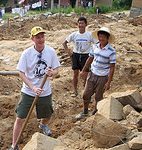China has significantly improved its information flow in the wake of the 8.0 magnitude earthquake that hit southwest China’s Sichuan province on May 12, which on May 20 had claimed more than 40,000 lives.
The 24-hour television news broadcasting and daily newspaper reports on the catastrophe and the rescue efforts, which came 12 days after new regulations on open government information took effect, have been widely praised by scholars and the international media as a symbol of China’s huge progress towards greater openness.
However, before we reach the conclusion that this new ruling has permanently improved the opening of information flows (leaving aside whether this constitutes transparency or not), additional measures and efforts are needed. And some of these measures must be implemented not only by government officials, but also by a wide range of people engaged in the process of communication.
One major such measure is to cover all information, not simply the information that benefits the information producers – primarily the government departments.
In the case of the Wenchuan earthquake, less than half an hour after the quake took place at 2.28pm on May 12, news of the quake from the China Earthquake Administration appeared on major Chinese news portals. It has subsequently been updated regularly on many Chinese websites.
In the following days, journalists were seen accompanying the first batch of rescuers, reporting from the collapsed buildings, the ruined villages, the devastated factories and twisted roads. Access for journalists, including the international media, saw almost no restrictions.
We should praise this lack of restrictions and also note how quickly the government responded to the natural disaster. The free access to information and widespread reporting has helped to show a very positive profile of the government. Hearing the touching and sincere speeches of premier Wen Jiabao at the ruins frequently brought tears to my eyes.
But there is more to communicate. There are many further reflections we should make, including reporting on possible man-made errors. These may include the poor construction of schools in the region and the impacts that the many dams along the Minjiang, or Min River, may have had on landslides caused by the quake.
We currently do not know whether the 100-plus dams along the river, which slowed the water flow and increased the amount of water in the soil and rocks on which urban and rural buildings were erected, have made landslides more common. But thorough research and investigation, as well as a wide-ranging discussion of the issues, are definitely needed.
It is worth mentioning that despite sporadic mentions of the possible impacts of the dams in media reports about the earthquake, no in-depth exploration of the possible links has been made. This is not only because of the lack of reliable information, but also because at the current stage, the consensus among rescue and media workers is to prioritise life-saving efforts, rather than apportioning blame for the disaster.
In one sense, this illustrates that when information flows freely, it will not necessarily lead to anyone making trouble: most people involved in the production of information and its transmission have the necessary ethical and pragmatic standards. And for the same reason, there is no need to worry about possible chaos if post-quake investigations into man-made errors are performed in an open and participatory manner. In a healthy society, public criticism of perceived government faults in various media can lead to constructive solutions, solutions that are often founded on the careful balancing of risks and benefits.
Aside from tolerating potentially critical reporting, many other institutional efforts are needed to ensure the free flow of information.
An open information policy does not only mean providing more information in a one-sided way, with no restrictions on access for journalists during natural disasters. Rather, it should represent an institutional way to facilitate the media and the public’s reasonable inquiries. This should include the timely provision of reliable and authoritative experts to reporters, the positive response to and interpretation of controversial information, and the training of officials and scientists to deal with the media. Reporters often demand quick and simple explanations, rather than a whole set of theories.
After the SARS outbreak in 2003, a spokesperson system was established across central and local government departments and major social institutions. While this has significantly improved the amount of information produced by the government, sometimes journalists find it more difficult to get the information they want because officials they approach simply turn to spokespersons, who often do not respond to interview applications, or not in a timely fashion.
A spokesperson is never omniscient, and it is understandable that he or she will not be able to handle all types of information. But they should become a medium to bridge journalists, scientists and officials in their separate institutions – rather than a blockage in the flow of sensitive or elusive information. It is important to note that in a diversified society, media – and the public they should represent – not only receive large amounts of information from the government, but are also a factor that helps the production and flow of essential information that is relevant to the public interest.
This open information flow, however, does not simply emerge from the efforts of government and other institutions. Media, including the press and online publications, should play a role in ensuring the flow of accurate information.
On May 12, minutes after the quake, many Beijing residents were startled to read stories – reportedly originating from people.com.cn — that a 2 to 6 magnitude earthquake was very likely to hit Beijing between 10pm and midnight that evening.
The authoritative China Earthquake Networks Centre soon denied the rumours and seismologists later explained that the predictions could not have come from a seismologist, because experts classify earthquakes smaller than a magnitude of 5 as small, while those larger than 5 are considered large. No professional seismologist would ever mention earthquakes of such differing magnitudes in the same statement.
We cannot judge whether this rumour was intentionally created or resulted from the misinterpretation of scientific opinion, but we do know that healthy and responsible professionalism for media workers – especially website editors – requires double-checking essential information of this kind with authoritative departments. If they had done so, it would have been easy to avoid such confusing and shocking information being released. It is undeniable that media professionalism needs to be improved, but it is also true that without positive efforts from the officials to deal with sensitive information, media professionalism cannot be cultivated in practice.
It is not easy for senior officials to accept open criticism, for experts involved in information to become adept at communicating with journalists, or for the media to accurately judge all information. But, as the Wenchuan earthquake has proved, opening information flows can bring such benefits that everyone engaged in the process should be working hard to achieve these goals.
Jia Hepeng is the China Regional Coordinator for Science and Development Network (SciDev.Net), a source of free news, views and analysis about science and technology in the developing world, as well as a promoter of science communication in the developing countries.
Homepage photo by wang qian 02/13/86



